 Sea Peoples? It sounds like a science-fiction movie, so now…
Sea Peoples? It sounds like a science-fiction movie, so now…
Jeremiah 37
Jeremiah’s Imprisonment
1 And king Zedekiah the son of Josiah reigned instead of Coniah the son of Jehoiakim, whom Nebuchadnezzar king of Babylon made king in the land of Judah.
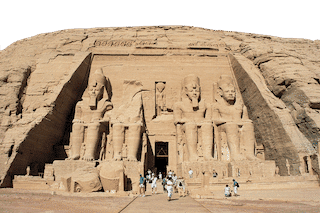
37:1-3:28 – during the last two years of Zedekiah’s reign (588-586 B.C.), Jeremiah is imprisoned by the authorities.
2 But neither he, nor his servants, nor the people of the land, did hearken unto the words of the LORD, which he spake by the prophet Jeremiah.
3 And Zedekiah the king sent Jehucal the son of Shelemiah and Zephaniah the son of Maaseiah the priest to the prophet Jeremiah, saying, Pray now unto the LORD our God for us.
“Jehucal the son of Shelemiah” – later became Jeremiah’s enemy.
4 Now Jeremiah came in and went out among the people: for they had not put him into prison.
5 Then Pharaoh’s army was come forth out of Egypt: and when the Chaldeans that besieged Jerusalem heard tidings of them, they departed from Jerusalem.
“Pharaoh’s army” – the troops of Pharaoh-hophra, called Apries by Greek historians.
“Come forth out of Egypt” – probably to help Zedekiah at his request; Lachish ostracon 3 mentions a visit to Egypt made by the commander of Judah’s army. All such ploys by Zedekiah would fail.
6 Then came the word of the LORD unto the prophet Jeremiah, saying,
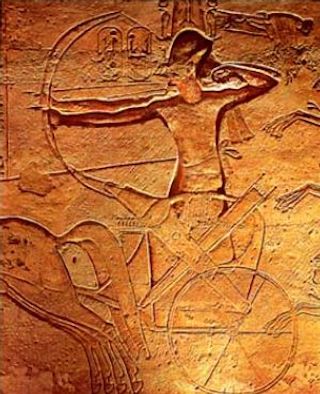
Part of Second Syrian campaign of Ramesses II
Ramesses atop chariot, at the battle of Kadesh. (Relief inside his Abu Simbel temple.)
Both sides claimed victory and negotiated peace treaty.
7 Thus saith the LORD, the God of Israel; Thus shall ye say to the king of Judah, that sent you unto me to enquire of me; Behold, Pharaoh’s army, which is come forth to help you, shall return to Egypt into their own land.
“Pharaoh’s army…return to Egypt” – Pharaoh-hophra would soon be defeated by Nebuchadnezzar.
8 And the Chaldeans shall come again, and fight against this city, and take it, and burn it with fire.
9 Thus saith the LORD; Deceive not yourselves, saying, The Chaldeans shall surely depart from us: for they shall not depart.
10 For though ye had smitten the whole army of the Chaldeans that fight against you, and there remained but wounded men among them, yet should they rise up every man in his tent, and burn this city with fire.
“Wounded” – Lit. “pierced through,” “morally wounded.” Though seriously handicapped, the Babylonians would still destroy Jerusalem.
11 And it came to pass, that when the army of the Chaldeans was broken up from Jerusalem for fear of Pharaoh’s army,
12 Then Jeremiah went forth out of Jerusalem to go into the land of Benjamin, to separate himself thence in the midst of the people.
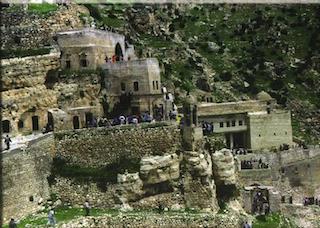
“Land of Benjamin” – where Jeremiah’s hometown, Anathoth, was located.
“To separate himself” – or “to buy land.” (see 1 Sam 30:24). While there was a brief lull in the Babylonian invasion. Jeremiah wanted to settle matters of estate with the other members of his family.
13 And when he was in the gate of Benjamin, a captain of the ward was there, whose name was Irijah, the son of Shelemiah, the son of Hananiah; and he took Jeremiah the prophet, saying, Thou fallest away to the Chaldeans.
14 Then said Jeremiah, It is false; I fall not away to the Chaldeans. But he hearkened not to him: so Irijah took Jeremiah, and brought him to the princes.
15 Wherefore the princes were wroth with Jeremiah, and smote him, and put him in prison in the house of Jonathan the scribe: for they had made that the prison.
“House of Jonathan” – Jeremiah would later look back on this prison as a place of great danger for him.
16 When Jeremiah was entered into the dungeon, and into the cabins, and Jeremiah had remained there many days;
“Dungeon” – Lit. “house of the cistern,” probably underground (see Ex 12:29).
17 Then Zedekiah the king sent, and took him out: and the king asked him secretly in his house, and said, Is there any word from the LORD? And Jeremiah said, There is: for, said he, thou shalt be delivered into the hand of the king of Babylon.
18 Moreover Jeremiah said unto king Zedekiah, What have I offended against thee, or against thy servants, or against this people, that ye have put me in prison?

Jer.50.1 The word that the LORD spake against Babylon and against the land of the Chaldeans by Jeremiah the prophet.
19 Where are now your prophets which prophesied unto you, saying, The king of Babylon shall not come against you, nor against this land?
20 Therefore hear now, I pray thee, O my lord the king: let my supplication, I pray thee, be accepted before thee; that thou cause me not to return to the house of Jonathan the scribe, lest I die there.
21 Then Zedekiah the king commanded that they should commit Jeremiah into the court of the prison, and that they should give him daily a piece of bread out of the bakers’ street, until all the bread in the city were spent. Thus Jeremiah remained in the court of the prison.
Sea Peoples
The Sea Peoples were a confederacy of naval raiders who harried the coastal towns and cities of the Mediterranean region between approximately 1276-1178 B.C., concentrating their efforts especially on Egypt.
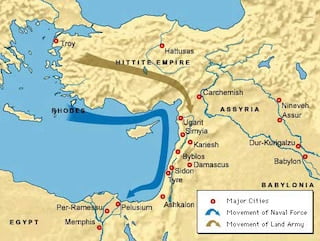
Several scholars have puzzled over whether the Sea Peoples were responsible for the collapse of some of the Late Bronze Age civilizations or simply one of several catalysts that put that collapse in motion. For sure the Sea Peoples movement was one of the largest and most important migration in history which changed the face of the ancient world more than any other single event before the time of Alexander the Great.
The nationality of the Sea Peoples remains a mystery as the only records we have of their activities are mainly Egyptian sources who only describe them in terms of battle (such as the record from the Stele at Tanis which reads, in part, “They came from the sea in their war ships and none could stand against them”).
Names of what may have been the tribes which comprised the Sea Peoples have been recorded as the Sherden, the Sheklesh, Lukka, Tursha and Akawasha. Outside Egypt, they also frequently assaulted the coastal regions of the Hittite Empire, the Levant and other areas around the Mediterranean coast.
Their origin and identity has been suggested (and debated) to be Etruscan/Trojan to Italian, Philistine, Mycenaen and even Minoan but, as no accounts discovered thus far shed any more light on the question than what is presently known, any such claims must remain mere conjecture.
The Sea Peoples are mentioned as allies of the Hittites by Ramesses II in his record of the Battle of Kadesh in 1274 B.C. and, in the second year of his reign, he defeated them in a naval battle off the coast of Egypt.
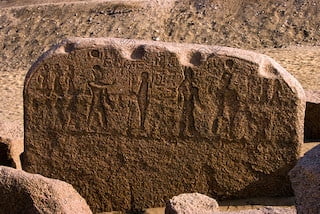
Tanis Temple Amon Stele Offering Gods Pharaoh Ramses Ancient Egyptian Delta Capital in Northern Egypt once thought to be the capital created by Ramses but was the capital of the 24th Nome of Lower Egypt and important in the late Egyptian period. Has Ramesside Temple of Amun with other temples from reigns of Osorkon, Sheshonq and Ptolemy but of special interest are the Royal Tombs where that of Psusennes in particular was intact and gave up one of the richest burial good collections, apart from Tutankhamun, with its famous silver coffin, now in the Cairo Museum. A visit to Tanis is usually by private means but can be incorporated with a day trip through the Delta visiting Heliopolis and Tell Basta but does involve considerable motoring.
Ramesses cleverly allowed the war ships and their supply and cargo vessels to approach the mouth of the Nile and attack what seemed to be a small defending Egyptian fleet, before launching his full attack upon them from their flanks and sinking their ships.
This battle involved (it seems) only the Sherdan Sea Peoples and after the battle many were pressed into Ramesses’ army and some served as his elite body guard.
Ramesses’ successor, Merneptah (1224-1214 B.C.) continued to be troubled by the Sea Peoples who allied themselves with the Libyans to invade the Nile Delta. At this point in their history it seems the Sea Peoples were seeking to establish permanent settlements in Egypt as the invading force brought with them scores of household goods and building tools.
Egyptian records tell us that Merneptah, after praying, fasting, and consulting the gods in the matter of strategy, met the Sea Peoples on the field at Pi-yer where the combined Egyptian force of infantry, cavalry and archers slew over 6,000 of their opponents and took captive members of the royal Libyan family.
During the reign of the Pharaoh Ramesses III (1194-1163 BCE) the Sea Peoples attacked and destroyed the Egyptian trading center at Kadesh (in modern day Syria) and then again attempted an invasion of Egypt.
They began their activities with quick raids along the coast (as they had done in the time of Ramesses II) before driving for the Delta. Ramesses III defeated them in 1180 B.C. but they returned in force.
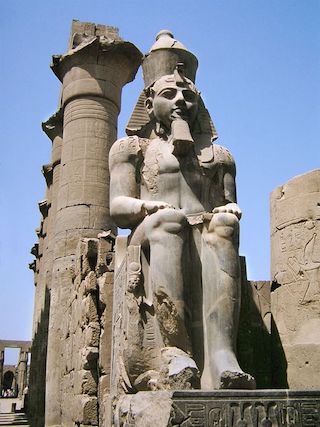
Ramesses II was the son of King Seti I and Queen Mut-Tuy. Ramesses is shown on a stela behind Seti I as the crown-prince. Ramesses had an older sister named Tia. Tia married a treasurer who was also named Tia, and this couple was buried in the necropolis of Saqqara, close to the tomb of Horemheb. Ramesses likely had another sister named Henutmire, and she became one of the wives of Ramesses.
Ramesses’ name is sometimes written as Ramessu or Ramses.
Ramesses then set up ambushes along the coast and the Nile and made especially effective use of his archers, positioning them hidden along the shoreline to rain down arrows on the ships at his signal, once they were in range.
Once the ships’ complement was dead or drowning the ships were set afire with flaming arrows and the Sea Peoples were finally defeated off the city of Xois in 1178 B.C. Egyptian records, again, detail a glorious victory in which many of the Sea Peoples were slain and others taken captive and pressed into the Egyptian army and navy or sold as slaves.
After their defeat by Ramesses III the Sea Peoples vanish from history, the survivors of the battle perhaps being assimilated into Egyptian culture. No records indicate where they came from and there are no accounts of them after 1178 B.C.
But, for almost one hundred years, they were the most feared sea raiders in the Mediterranean region and a constant challenge to the might and prosperity of Egypt.
…I want to know about the Hittites, especially since they were allies with the Sea Peoples.
Visits: 0
